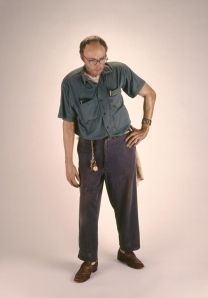If recent exhibitions give a clue, museums seem to think that visitors want to know more about conservation — and I think they’re right. Conservation obviously provides a window on process, on how the artist did it, on creativity. Â
 Recently the Milwaukee Art Museum conserved a sculpture by Duane Hanson, which it had agreed to lend to the Walker Art Center in Minneapolis for an exhibition called LifeLike — “artworks based on commonplace objects and situations, which are startlingly realistic, often playful, and sometimes surreal.” This job, rather than an exhibition for the conservation work, had a good story behind it, and merited extensive blog post recounting of the process, which I’d like to share.Â
Recently the Milwaukee Art Museum conserved a sculpture by Duane Hanson, which it had agreed to lend to the Walker Art Center in Minneapolis for an exhibition called LifeLike — “artworks based on commonplace objects and situations, which are startlingly realistic, often playful, and sometimes surreal.” This job, rather than an exhibition for the conservation work, had a good story behind it, and merited extensive blog post recounting of the process, which I’d like to share.Â
Hanson’s hyperrealistic sculptures — beloved by people but often belittled by critics — aren’t easy to tend. They are, in fact, the subject of vandalism at times, with people lifting small items from them. In Milwaukee, for example, the museum conservators had to seek out ballpoint pens from the late 60s and early 70s, because people had taken them from their Janitor (1973). They also had to clean his uniform, which proved highly difficult when they realized they couldn’t remove the clothes without taking apart the sculpture.
Did they or didn’t they? Read the answer here. Â
And how do conservators restore the Janitor’s human hair? Says MAM’s Senior Conservator, Jim DeYoung:
We found a letter written in 1974 from Duane Hanson and it demonstrates that he was very involved with the owners of his artwork in their care and maintenance of these artworks. We read that Hanson was not only involved himself, but that he was eager to get other people involved, too. In this case, he had no problem packing human hair into the letter and instructing how to attach the hair with the gluing method and so forth. So this gave us a bit of a road map in what we thought was ethical to do to, how much latitude we had in caring for the artwork, and how much artistic license we had to move ahead with plans to bring the janitor to its original condition.
What to do about that ’60s watch? And his fraying pocket? It’s all on that post, by assistant curator Mel Buchanan. I enjoyed it.
Photo Credit: Courtesy of the Milwaukee Art Museum
